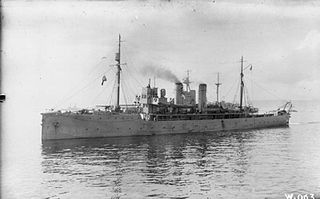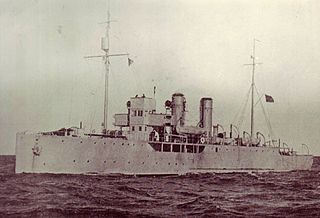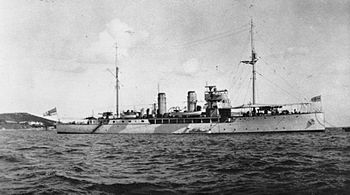HMS Mallow was an Acacia-class sloop built for the Royal Navy, and later operated by the Royal Australian Navy (RAN) as HMAS Mallow.
HMS Veronica was an Acacia-class sloop of the Royal Navy. She served during World War I. Post-war, she saw New Zealand service.

HMS Opal was an Admiralty M-class destroyer of the Royal Navy. She served in the First World War following her construction at Sunderland in 1915. Attached to the 12th Destroyer Flotilla based with the Grand Fleet at Scapa Flow, Opal had an eventful short life, which ended in shipwreck after two and a half years of service.

The Acacia class was a class of twenty-four sloops that were ordered in January 1915 under the Emergency War Programme for the Royal Navy in World War I as part of the larger Flower class which were also referred to as the "Cabbage class", or "Herbaceous Borders". They were ordered in two batches, twelve ships on 1 January and another twelve on 12 January, and all were launched within about four or five months, and delivered between May and September 1915. They were used almost entirely for minesweeping until 1917, when they were transferred to escort duty.
HMS D5 was one of eight D-class submarines built for the Royal Navy during the first decade of the 20th century.

HMS Carlisle was a C-class light cruiser of the Royal Navy, named after the English city of Carlisle. She was the name ship of the Carlisle group of the C-class of cruisers. Carlisle was credited with shooting down eleven Axis aircraft during the Second World War and was the top scoring anti-aircraft ship in the Royal Navy.

HMS Brilliant was an Apollo-class cruiser of the British Royal Navy which served from 1893 to 1918 in various colonial posts and off the British Isles as a hastily converted minelayer during the First World War.

HMS Defender was an Acheron-class destroyer which was built in 1911, served throughout World War I and was broken up in 1921. She was the fifth ship of the name to serve in the Royal Navy.
SS Hong Moh was a passenger ship that was wrecked on the White Rocks off Lamock Island, Swatow, on 3 March 1921 with the loss of about 900 lives.
HMS Arabis was an Arabis-class sloop of the Royal Navy. She had a brief career, serving during the First World War.
HMS Snowdrop was an Azalea-class sloop of the Royal Navy. She served during the First World War. Snowdrop survived the war and was sold for scrap in 1923.

HMS Laburnum was a Royal Navy Acacia-class sloop built by Charles Connell and Company, Scotstoun. She was scuttled during the fall of Singapore in 1942.
HMS Bluebell was an Acacia-class minesweeping sloop of the Royal Navy launched on 24 July 1915.
HMS Ouse was a Laird type River-class destroyer ordered by the Royal Navy under the 1903 – 1904 Naval Estimates. Named after the River Ouse in north east England near the city of York, she was the first ship to carry this name in the Royal Navy.

HMS Chelmer was a Thornycroft Type River Class destroyer ordered by the Royal Navy under the 1903–1904 Naval Estimates. Named after the River Chelmer in eastern England, north-east of London, she was the first ship to carry this name in the Royal Navy.
HMS Gentian was an Arabis-class sloop that was sent to assist the Baltic States and their fight for independence. While clearing mines on 15 or 16 July 1919, according to different sources, Gentian and the sloop HMS Myrtle both hit mines and sank with the loss of nine sailors.

HMS Zinnia was an Azalea-class minesweeping sloop of the Royal Navy, built in 1915 at the Swan Hunter & Wigham Richardson yard, at Wallsend in the United Kingdom.It was sold to Belgium on 19 April 1920 to join their new Corps of Destroyers and Sailors.
HMS Cornflower was an Arabis-class sloop of the Royal Navy and from 1933 the Hong Kong Naval Volunteer Force (HKNVR).

HMS Rosemary was an Arabis-class minesweeping sloop of the British Royal Navy. Built by the Teesside shipbuilder Richardson, Duck and Company from 1915–1916, Rosemary carried out minesweeping and anti submarine operations during the First World War. She was used for fishery protection duties during the 1930s, and served through the Second World War, finally being sold for scrap in 1947.
HMS Alyssum was an Arabis-class minesweeping sloop of the British Royal Navy which served during the First World War. Alyssum was built in 1915 by Earle's Shipbuilding, and was used for minesweeping, escort and patrol duties in the North and Irish Seas. The sloop sank after hitting a German mine on 18 March 1917.









